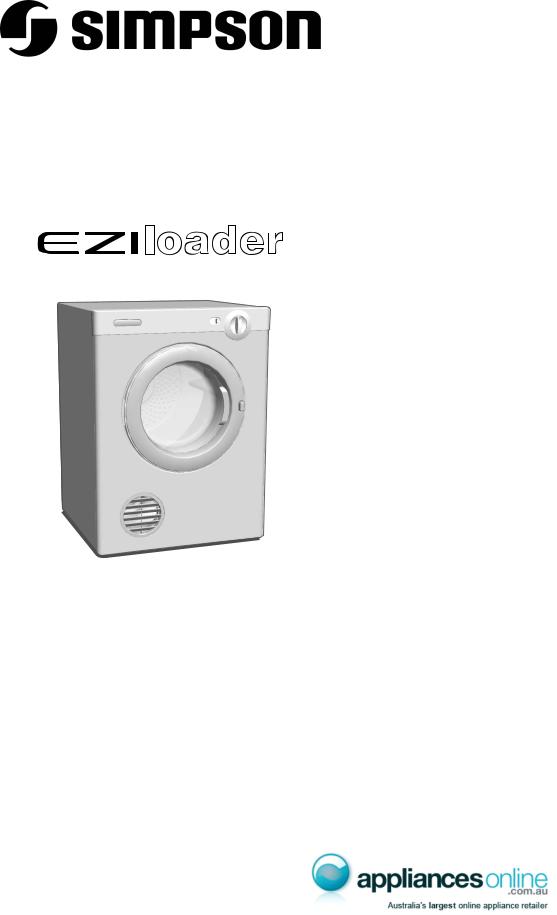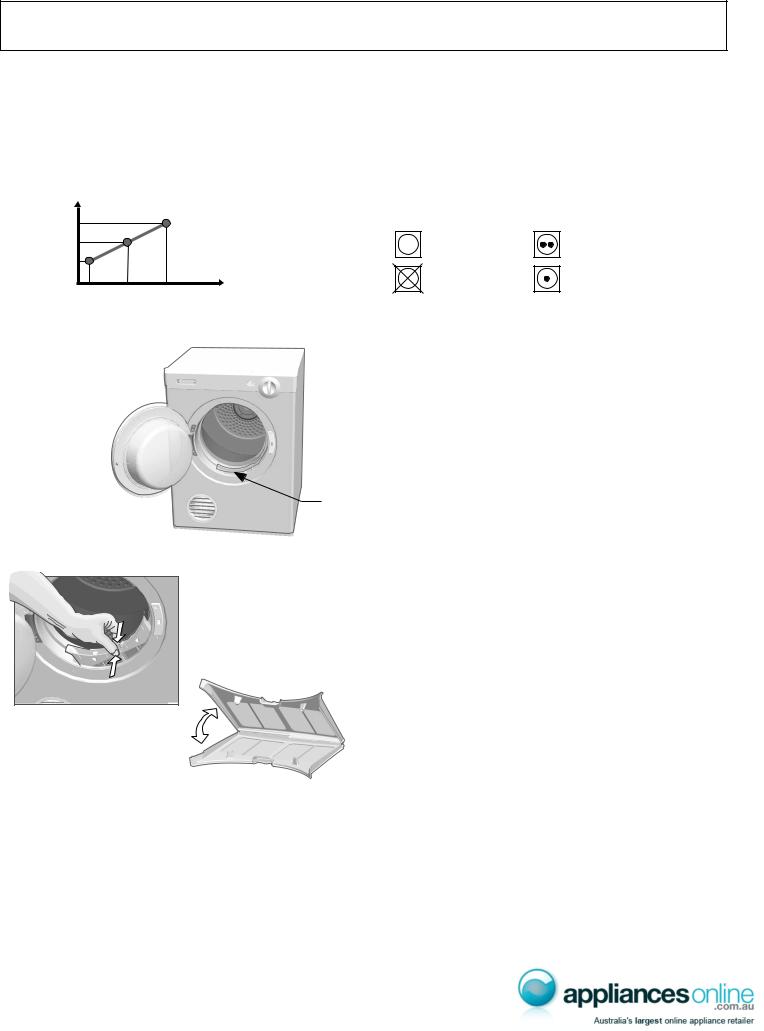Simpson EZI loader User Manual

Q u a l i t y ke pt s i m p l e
Clothes Dryer
Instruction Booklet
Congratulations on your choice of clothes dryer which will give you many years of easy loading and easy drying in the Simpson tradition

Contents
Important Safety Information |
|
Dryer Safety |
page 2 |
Fire Hazards |
page 2 |
Cleaning the Lint Filter |
page 3 |
Drying Guide |
page 3 |
Installation Instructions |
page 4 |
Quick 5 Step Operating Guide |
page 5 |
Useful Hints |
page 5 |
Useful Hints (continued) |
page 6 |
Troubleshooting |
page 6 |
Accessories |
page 6 |
Warranty |
page 7 |
Purchase Details |
page 8 |
Important Safety Instructions
DRYER SAFETY
Failure to follow these safety instructions could damage the dryer or your clothes.
You may then not be covered by warranty for this damage.
Only plug this appliance directly into an AC power supply, which is properly earthed and has the correct voltage. See the serial number sticker located on the top of the door opening for voltage information.
CAUTION: If this appliance is supplied from a cord extension set or electrical portable outlet device, the cord extension set or electrical portable outlet device must be positioned so that it is not subject to splashing or ingress of moisture. For safety reasons we strongly advise against the use of double adaptors, extension cords or power boards.
This tumble dryer is not intended for use by young children or infirm persons without supervision. Young children should be supervised to ensure that they do not play with the appliance.
IMPORTANT: If the electrical cord of this appliance is damaged, it must be replaced by the Manufacturer, Authorised Service Agent or similarly qualified person in order to avoid a hazard.
These dryers are for drying clothes, towels and linen at home. Do not use them for any other purpose.
FIRE HAZARDS
Some fabrics are not suitable for tumble drying. The following MUST NOT be placed in your dryer due to the risk of a fire or an explosion:
Items that have been spotted or soaked with vegetable oil, cooking oil, suntan oil, linseed oil, salad oil, lubrication oil or grease. Oil affected items can ignite spontaneously, especially when exposed to heat sources such as in a tumble dryer. The items become warm, causing an oxidation reaction in the oil. Oxidation creates heat. If heat cannot escape, the items can become hot enough to ignite. Piling, stacking, or storing oil-affected items can prevent heat from escaping and create a fire hazard. If it is unavoidable that fabrics that contain vegetable or cooking oil, or have been contaminated by hair care products be placed in a tumble dryer, they should first be washed in hot water with extra detergent - this will reduce, but not eliminate the hazard. The ‘cool down’ cycle of tumble dryers should be used to reduce the temperature of the items. They should not be removed from the tumble dryer or piled while hot.
Items that have previously been cleaned in, washed in, or spotted with petrol/gasoline, industrial chemicals used only for cleaning, dry-cleaning solvents or other flammable or explosive substances. Highly flammable substances commonly found around the house include acetone, (nail polish remover) denatured alcohol, petrol/gasoline, kerosene, some spot removers, turpentine, waxes and wax removers. Items containing foam rubber (also known as latex foam) or similarly textured rubber-like materials. Foam rubber materials can produce fire by spontaneous combustion when heated.
Rubber-backed articles, clothes fitted with foam rubber pads, pillows, rubber boots and rubber-coated sports shoes.
For your safety, and to reduce the risk of fire or an explosion,
DO NOT store or use petrol or other inflammable vapours and liquids near your dryer.
2

Important Safety Instructions
LINT BUILD-UP IS A FIRE HAZARD
A clean lint filter reduces drying times, saves energy and avoids overheating. Overheating may also damage your clothes.
What happens if I forget to clean the lint filter?
Drying Time
tripled doubled normal
1 5 9
Number of usages with an unclean lint filter
(based on laboratory tests using a load of new towels)
The lint filter is located at the front of your dryer at the bottom of the door opening.
LINT
FILTER
You must clean this lint filter after every load.
remove the lint filter open To remove the lint filter
the door and press the two open the door and press
pads together. Pull the lint the two pads together.
filter out of the pocket. Pull the lint filter out of
the pocket.
Open apart the lint filter and wipe or peel off the lint.
Ensure the lint filter ‘clicks’ when replacing. It can be inserted into the pocket either way.
Never operate your dryer without the lint filter.
Do not allow lint to build up around your dryer.
A torn or damaged lint filter must be replaced immediately.
Overloading can increase lint build-up because the airflow is reduced.
To avoid potential fire hazards, we recommend that you pay a qualified service technician to periodically clean your dryer. You must do this also when you change your mounting from upright to inverted, or vice versa.
DRYING GUIDE
Your load, when dry must not exceed the rated capacity.
4kg for the 4kg Machine
5kg for the 5kg Machine
6kg for the 6kg Machine
(See page 6 for a table of average weights of laundry items)
Always check your labels for the drying symbols which the International Care Labelling Code now uses.
May be tumble dried |
Normal drying (high temperature) |
Do Not Tumble Dry |
Delicate drying (low temperature) |
Permanent press and synthetics - take out as soon as the dryer stops to reduce wrinkles.
Woollen articles - not recommended. Pull them to their original shape, then dry them flat.
Woven and loop knit materials - may shrink, by varying amounts, depending on their quality. Do not use the ‘hot’ setting for these fabrics. Always stretch them out immediately after drying.
Fibre or leather materials - always check the manufacturer’s instructions.
Baby clothes and night gowns - acrylic clothing or sleepwear use only on the ‘warm’ setting.
Rubber and plastics - Do not dry any items made from or containing rubber or plastics, such as aprons, bibs, babies’ waterproof napkins, curtains, tablecloths, shower caps, clothes fitted with foam rubber pads, pillows, galoshes, or rubber coated tennis shoes.
Fibreglass - not recommended. Glass particles left in the dryer could be picked up by your clothes the next time you use the dryer, and irritate your skin.
During the drying cycle, if you want to
add or take out clothes, or
check the dryness of the load,
turn down the timer to ‘Airing’ for at least one minute before opening the door. This is to prevent scorching or possible self combustion of the fabric.
Fabric softeners or similar products should not be used in a tumble dryer to eliminate the effects of static electricity unless this practice is specifically recommended by the manufacturer of the fabric softener or product.
Note: We strongly advise against the use of fabric conditioners of the sheet type that are added to the clothes in the drum. These products may lead to rapid blockage of the lint filter and inefficient operation of your dryer.
3
